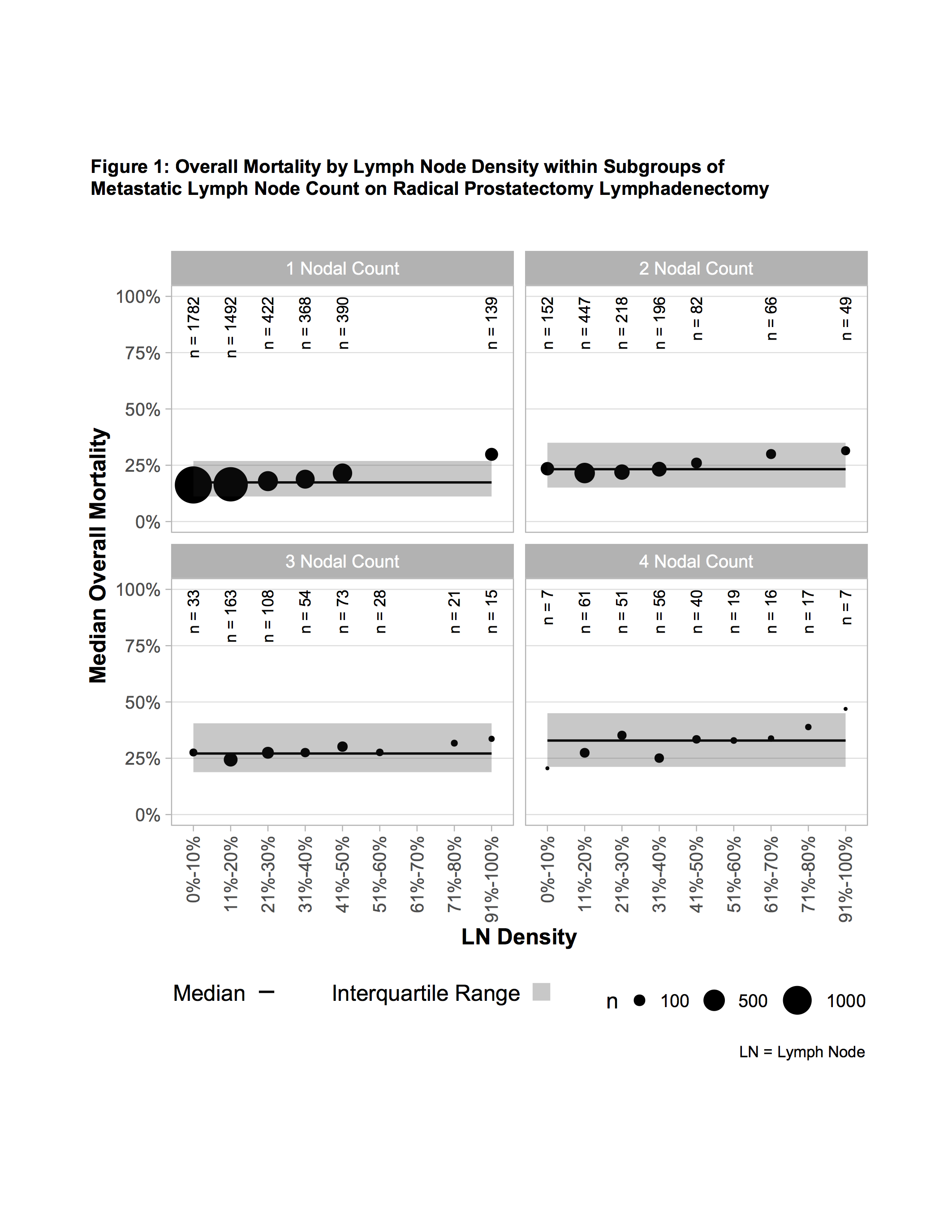Back
Poster, Podium & Video Sessions
Podium
PD03: Prostate Cancer: Epidemiology & Natural History I
PD03-05: Prognostic Value of Lymph Node Count versus Lymph Node Density for Men with Pathological Node-Positive Prostate Cancer
Friday, May 13, 2022
7:40 AM – 7:50 AM
Location: Room 245
Aurash Naser-Tavakolian*, Timothy Daskivich, Michael Luu, Zachary Zumsteg, Los Angeles, CA

Aurash NaserTavakolian, MD
Cedars-Sinai Medical Center
Podium Presenter(s)
Introduction: We recently found that the number of metastatic lymph nodes (+LN) strongly predicts overall mortality (OM) in men with pathological node-positive prostate cancer and created a novel pathological staging system based on +LN count. Previous work has suggested that LN density also predicts OM. We sought to determine the relative impact of pathological +LN count versus LN density on OM.
Methods: We sampled 229,547 men with nonmetastatic prostate cancer who underwent radical prostatectomy and lymphadenectomy from the National Cancer Database. A multivariable Cox proportional hazards model with restricted cubic spline was used to assess the non-linear interaction between +LN count and LN density (number of positive LN/total LN sampled) and OM. The multivariable model was used to estimate OM at 96 months. We then assessed the distribution of LN density and the variation in OM explained by LN density within +LN count subgroups using median and interquartile range.
Results: In multivariable analysis, OM increased with each successive metastatic LN up to four positive nodes (HR 1.14, 95%CI 1.06–1.23 for each node), with no significant increase in risk observed beyond 4 LN. LN density was also an independent predictor of OM (HR 1.09, 95%CI 01.06–1.12 for each 10% increase in LN density). The interaction between LN count and density was not significant (p=0.5). The distribution of LN density within subgroups of +LN count was narrow, especially for patients with low numbers of +LNs (Figure 1). For example, for men with 1 and 2 +LN, the median (IQR) for LN density was 14% (8%,25%) and 22% (13%,33%), respectively. As a result, the variation in OM explained by LN density within +LN count subgroups was modest, especially for patients with low numbers of +LNs. For example, among men with 1 +LN, the median OM (IQR) for those with LN density of 0-10%, 11-20%, 21-30%, 31-40%, and 41-50% (these groups comprising 97% of all men with 1 +LN) was 16% (10%,25%), 17% (10%,26%), 18% (11,28%), 19% (12%,29%), and 22% (14%,32%), respectively (Figure 1).
Conclusions: While +LN count and LN density independently predict OM in men with node-positive prostate cancer, the impact of LN density is modest compared with +LN count, especially in men with a low number of +LN. Pathological nodal staging should primarily rely on LN count rather than LN density.
Source of Funding: No funding.

Methods: We sampled 229,547 men with nonmetastatic prostate cancer who underwent radical prostatectomy and lymphadenectomy from the National Cancer Database. A multivariable Cox proportional hazards model with restricted cubic spline was used to assess the non-linear interaction between +LN count and LN density (number of positive LN/total LN sampled) and OM. The multivariable model was used to estimate OM at 96 months. We then assessed the distribution of LN density and the variation in OM explained by LN density within +LN count subgroups using median and interquartile range.
Results: In multivariable analysis, OM increased with each successive metastatic LN up to four positive nodes (HR 1.14, 95%CI 1.06–1.23 for each node), with no significant increase in risk observed beyond 4 LN. LN density was also an independent predictor of OM (HR 1.09, 95%CI 01.06–1.12 for each 10% increase in LN density). The interaction between LN count and density was not significant (p=0.5). The distribution of LN density within subgroups of +LN count was narrow, especially for patients with low numbers of +LNs (Figure 1). For example, for men with 1 and 2 +LN, the median (IQR) for LN density was 14% (8%,25%) and 22% (13%,33%), respectively. As a result, the variation in OM explained by LN density within +LN count subgroups was modest, especially for patients with low numbers of +LNs. For example, among men with 1 +LN, the median OM (IQR) for those with LN density of 0-10%, 11-20%, 21-30%, 31-40%, and 41-50% (these groups comprising 97% of all men with 1 +LN) was 16% (10%,25%), 17% (10%,26%), 18% (11,28%), 19% (12%,29%), and 22% (14%,32%), respectively (Figure 1).
Conclusions: While +LN count and LN density independently predict OM in men with node-positive prostate cancer, the impact of LN density is modest compared with +LN count, especially in men with a low number of +LN. Pathological nodal staging should primarily rely on LN count rather than LN density.
Source of Funding: No funding.


.jpg)
.jpg)